The aggregation of any data for purposes of analytics
requires some level of consistency between disparate and unique systems or
devices. One cannot expect to dump rotten vegetables into a cauldron of boiling
water and serve gourmet soup from that mess.
How Good or Bad Is It?
On a scale of 1 to 10 just how good is all of that data that
is being generated throughout the agri food chain? 1? Probably not. Certainly
not anywhere near 10. I would argue that it is poor, at best, but improving
rapidly.
Without standardization, normalization, calibration
and validation the industry will not achieve the level of accuracy that is
required for good and consistent actionable analytics when the data is
aggregated.
A Rose by Any Other Name
The ag chemical industry has been working on the problem of
not simply coming up with the global names for products but also digitizing the
rules associated with the use of those products. It seems that they may be
inching closer to solutions for these issues and in some cases the government
regulatory agencies are moving in a similar direction towards that goal. One
farmers’ “Roundup” might be anothers’ “round up”. This is a good start.
Straight from the Horse’s Mouth
The recording of events by hand will always be necessary in
the business of growing and processing foods. However, the automation of that
data collection or recording is increasing at an incredible rate due to the proliferation
of IoT (Internet of Things) and data digitization.
Everything from irrigation, to weather, to seeding, to yields, to fertilizers, to pesticides, to invoices, to, well, just about anything that happens on the farm or at the plant is available from some computer somewhere in a raw and unfiltered form.
Everything from irrigation, to weather, to seeding, to yields, to fertilizers, to pesticides, to invoices, to, well, just about anything that happens on the farm or at the plant is available from some computer somewhere in a raw and unfiltered form.
Maytag Effect
The big data folks at IBM or Google will tell you that there
is a “scrubbing” process that inherently has the intelligence to recognize that
“Roundup” is the same as “round up”. These
applications also can determine the source of the data and appropriately modify
the values in an effort to normalize the data. In short, the data can be
cleaned through a process.
Industry Associations and Certification
Having worked in the processing tomato industry for many
years I recognize that industry associations, similar to the Processing Tomato
Advisory Board, which is made up of both grower and processor representatives,
can help in data standardization. Every load of tomatoes goes through a
standard receiving and grading process and the resultant data can be aggregated
and analyzed to the benefit everyone in the industry – farmer and packer alike.
When there is the will to do so and an understanding of the value of data these
goals can be achieved.
Other associations could do the same. Think of the wealth in
data value if the American Farm Bureau took an active role in establishing a
true “data dictionary” and assisted in the establishment of standardization,
normalization, calibration and validation protocols for the farm.


